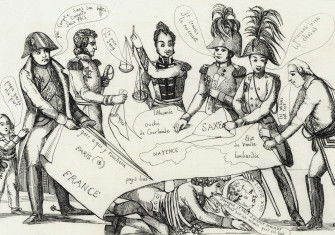Dark Days: Prussia’s Winter of Discontent
For German national identity, winter is a metaphor that keeps on giving.
 The challenge posed – and admirably met – by the British Museum’s winter exhibition Germany: Memories of a Nation is best captured in a quote attributed to Johann Wolfgang von Goethe: ‘Germany? Where is it? I do not know where to find such a country’.
The challenge posed – and admirably met – by the British Museum’s winter exhibition Germany: Memories of a Nation is best captured in a quote attributed to Johann Wolfgang von Goethe: ‘Germany? Where is it? I do not know where to find such a country’.
The exhibition – and accompanying Radio 4 documentary series – establishes that Germany, for much of its history, has existed as an idea rather than a geographical entity; as such it preternaturally suits an exhibition aiming to give tangible shape to history.
One key defining point in this – and, for that matter, any – narrative of German history is 1806, when Napoleon’s invasion ended a thousand years of the Holy Roman Empire. Until 1806, ‘Germany’ consisted of around 350 disparate monarchies, principalities and dukedoms; Napoleon’s Rheinbund (or Confederation of the Rhine, 1806–1813) reduced that number to around 35.
Faced with a familiar French foe, the Germans – disparate though they were – sought ways of forging a national identity that could exist without reference to a defined geographical space. Memories of a Nation suggests a few such unifying features adopted by the early nineteenth-century nationalists: the German language, as refined by Martin Luther and spread by the Brothers Grimm (with the help of Johannes Gutenberg); German beer; German iron; the illustrious German nationals enshrined in Ludwig I’s Walhalla memorial. But has another (seasonally opportune) agent of unification been overlooked by the curators? Adam Gopnik, in his book Winter: Five Windows on the Season (Quercus, 2012, originally written for the 2011 Massey Lectures), has suggested so. Gopnik writes:
When Napoleon invades Germany in 1806, images of winter, which first have essentially a spiritual resonance, suddenly mark the arrival of modern nationalism in art. For what Germany has that France does not have is winter, a real winter, and its assertion in art marks the assertion of the German national genius.
There is an initial point of contention to be raised here: are German winters any more severe than French winters? ‘Resistance to Napoleon [is] a form of national self-assertion, and the embrace of winter is its engine’, Gopnik continues,
The metaphors of the Enlightenment are those of sunlight […] warmth, light, the sun returning to warm the human mind. The imagery of winter works both as a thing to give identity to the newly unifying (or just beginning to be unified) German nation and also as a symbol of the things that the French Enlightenment and French reason will never understand.
The Chasseur in the Forest depicts a French soldier lost in a wintery German forest. ‘It is a picture not only about nationalist resistance to the French’, says Gopnik, ‘it’s also about northern German resistance […] to the Enlightenment idea of reason’.
The argument that winter, the season and all it embodies, became in the early nineteenth century a reference point for an emerging German national identity is – like the Romantic paintings it utilises – inviting. Does it withstand historical interrogation? Speaking as part of the Memories of a Nation radio series, historian of Prussia Christopher Clark discusses an iron necklace from 1806 and the Iron Cross. The use of iron is illustrative of the Prussian public’s rejection of extravagance and adoption of frugality: ‘this is a time of abstinence and deprivation’, says Clark: ‘there is something interesting about the link between a particular kind of austerity and the identity of Prussia’. Winter, of course, is the most austere season in a literal sense: it is hard to imagine a richer metaphor for perseverance in the face of hardship or of a more fertile terrain for the expression of beauty amid dark days and death. ‘Winter is certainly an important topic for the German Romantics’, says William Vaughan, Emeritus Professor of History of Art at Birkbeck College, when I ask him to assess Gopnik’s claim. ‘I have always thought that Friedrich's paintings The Monk by the Sea (1808) and The Abbey in the Oakwood (1809-10) were received so well in Berlin - they were bought by the Prussian Crown in 1810 - because their wintry imagery embodied the notion of Germany surviving in times of hardship. It is noticeable that he really begins to paint winter scenes a lot during the time of the Napoleonic Invasions.'
For Professor Henk de Berg, Head of German at the University of Sheffield, positioning German nationalism in opposition to the Enlightenment via winter is problematic. ‘Many German intellectuals were actually in favour of the liberal “code Napoléon” he says. ‘German nationalists wanted to see an end to “feudal particularism”, marked by the lack of individual freedom, and replace it in a unified Germany with freedom of speech and assembly’. In this light Friedrich’s work, in particular his painting Das Eismeer (1823/4) might be read differently. ‘This image of arctic winter and devastation, the ship wrecked in the sea of ice, symbolises political paralysis after the Vienna Congress and, especially, the Carlsbad Decrees of 1819, which introduced a number of repressive laws’, says de Berg. ‘The hopes of many Germans after the Enlightenment and the French Revolution were wrecked just like the ship. Many people draw a parallel between this painting and Théodore Géricault’s The Raft of the Medusa (1819); it is not an image of winter being used to embrace anti-Enlightenment ideals, but rather as the very opposite; lamenting their lack.’
Across London, at the Royal Academy, is a major retrospective of Anselm Kiefer, another German artist with a penchant for winter landscapes. The art here is contemporary, though, and the German national identity being provocatively scoured is defined by a more cataclysmic event than the dissolution of the Holy Roman Empire. In Winterlandschaft (1970) and Black Flakes (2006), snow – echoing the closing lines of James Joyce’s ‘The Dead’ – covers the dead and the living alike. What horrors lie beneath its ephemeral, transparent and feeble cover? If absence is the highest form of presence, then Kiefer's use of winter with its complete absence of life is telling. Whether German Romantics did use winter to embrace anti-Enlightenment ideals, or to highlight Germany’s failure to emerge into the nineteenth century as a enlightened state, Kiefer’s work – ambiguous and often sublime – faces a real period of anti-Enlightenment the country’s history with winter’s haunting absence of life as a key component of its visual language. For German national identity – and times of hardship – winter is a metaphor that keeps on giving.
Germany: Memories of a Nation is at the British Museum, London, until 25 January
Anselm Kiefer is at the Royal Academy, London, until 14 December
Rhys Griffiths is editorial assistant at History Today






